Related Research Articles

Jacqueline Cochran was an American pilot and business executive. She pioneered women's aviation as one of the most prominent racing pilots of her generation. She set numerous records and was the first woman to break the sound barrier on 18 May 1953. Cochran was the wartime head of the Women Airforce Service Pilots (WASP) (1943–1944), which employed about 1000 civilian American women in a non-combat role to ferry planes from factories to port cities. Cochran was later a sponsor of the Mercury 13 women astronaut program.

Nancy Harkness Love, born Hannah Lincoln Harkness, was an American pilot and commander during World War II. She earned her pilot's license at age 16. She worked as a test pilot and air racer in the 1930s. During World War II she convinced William H. Tunner to look to set up a group of female pilots to ferry aircraft from factories to air bases. This proposal was eventually approved as the Women's Auxiliary Ferrying Squadron. Love commanded this unit and later all ferrying operations in the newly formed Women Airforce Service Pilots. She was awarded the Air Medal for her work during the war and was appointed lieutenant colonel in the US Air Force Reserve in 1948.

William Henry Tunner was a general officer in the United States Air Force and its predecessor, the United States Army Air Forces. Tunner was known for his expertise in the command of large-scale military airlift operations, first in Air Transport Command (ATC) during World War II, commanding The Hump operation, and later in Military Air Transport Service (MATS) during the Berlin Airlift in 1949–1951. He eventually rose to the rank of Lieutenant general and commanded MATS itself.
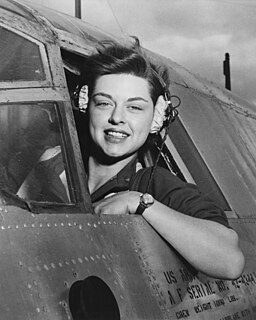
The Women Airforce Service Pilots (WASP) was a civilian women pilots' organization, whose members were United States federal civil service employees. Members of WASP became trained pilots who tested aircraft, ferried aircraft, and trained other pilots. Their purpose was to free male pilots for combat roles during World War II. Despite various members of the armed forces being involved in the creation of the program, the WASP and its members had no military standing.

Hazel Ying Lee was an American pilot who flew for the Women Airforce Service Pilots (WASP) during World War II.

Cornelia Clark Fort was a United States aviator who became famous for being part of two aviation-related events. The first occurred while conducting a civilian training flight at Pearl Harbor on December 7, 1941, when she was the first United States pilot to encounter the Japanese air fleet during the Attack on Pearl Harbor. She and her student narrowly escaped a mid-air collision with the Japanese aircraft and a strafing attack after making an emergency landing.

The Air Transport Auxiliary (ATA) was a British civilian organisation set up at the start of the Second World War with headquarters at White Waltham Airfield in Berkshire. The ATA ferried new, repaired and damaged military aircraft between factories, assembly plants, transatlantic delivery points, maintenance units (MUs), scrapyards, and active service squadrons and airfields, but not to naval aircraft carriers. It also flew service personnel on urgent duty from one place to another and performed some air ambulance work. Notably, some of its pilots were women, and from 1943 they received equal pay to their male colleagues, a first for the British government.
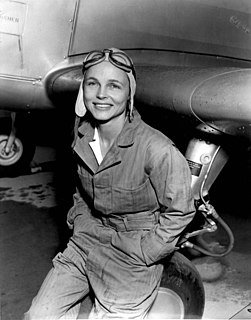
Betty Gillies was an American aviator, and the first pilot to qualify for the Women's Auxiliary Ferrying Squadron, later amalgamated into the Women Airforce Service Pilots.
Evelyn Genevieve "Sharpie" Sharp was an American aviator.

Avenger Field is a Texas airport in Nolan County, three miles west of Sweetwater. The National Plan of Integrated Airport Systems for 2011–2015 called it a general aviation facility.
Suzanne "Sue" Upjohn DeLano Parish was an American aviator. Parish was a member of the Women Airforce Service Pilots (WASPs) during World War II. In 1977, with her husband, Pete Parish, she was the co-founder of the Kalamazoo Aviation History Museum, later known as the Air Zoo, after the animal nicknames of the planes.
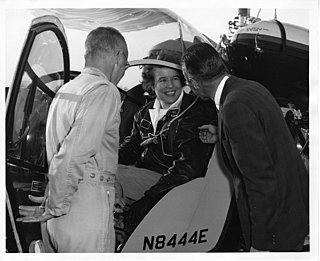
Dora Jean Dougherty Strother was an American aviator best known as a Woman Airforce Service Pilots (WASP) and B-29 Superfortress demonstration pilot. She was a U.S. military pilot, human factors engineer with Bell Aircraft, instructor at the University of Illinois and helicopter test pilot for Bell Aircraft.

Nancy Batson Crews (1920-2001) was one of the original women to participate in the Women's Auxiliary Ferrying Squadron (WAFS) during World War II.

Elaine D. Harmon was an American from Maryland who served in the U.S. Women Airforce Service Pilots (WASP) during World War II. In 2009 she received a Congressional Gold Medal for her service as a pilot during World War II. As a WASP pilot, she has been accorded full military honors at Arlington National Cemetery. In 2016, Ms. Harmon was posthumously inducted into the Maryland Women's Hall of Fame.

Elizabeth Maxine Chambers was one of the first female pilots in the Women Airforce Service Pilots (WASP) program in which women took on non-combat flying duties so more male pilots were available for combat. She was in WASP Class of 44-W-3 as part of the 318th Army Air Forces Flying Training Detachment. She became a pilot shortly after her husband lost his life while flying, despite the fact that she had a new baby, and was the only recent widow and mother to have served as a WASP.
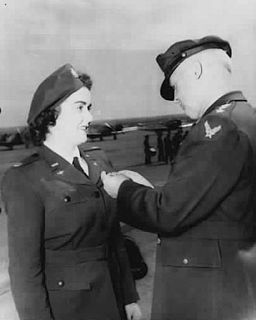
Barbara Erickson London was a Women Air-force Service Pilot (WASP) and a member of the Women's Auxiliary Ferrying Squadron (WAFS). She was a ferry pilot – picking up and delivering various military aircraft to and from factories and airbases throughout the United States. She won the Air Medal, and was the only woman awarded one in World War II.
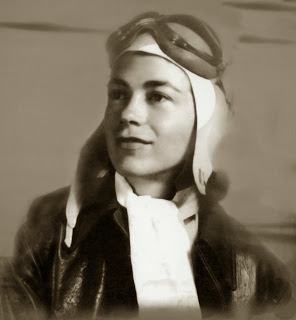
Dorothy Swain Lewis was an American aviator who trained Navy pilots and flew with the Women Airforce Service Pilots (WASP) program during World War II. She was also an artist who created a series of cast-bronze sculptures of WASP pilots for various World War II memorial sites.

Hazel Jane Raines was an American pioneer aviator and flight instructor with the Civilian Pilot Training Program. During World War II, she was part of the first group of United States women to fly military aircraft, which they did in a war zone for the civilian British Air Transport Auxiliary. She was later a member of the civilian contract labor Women Airforce Service Pilots. After the war, she taught instrument training in Brazil. When President Harry S. Truman authorized the integration of women into the military, she served with Women in the Air Force and was based in Texas, Alabama, and finally London until her death. Raines was the first woman in Georgia to earn a pilot's license, and has been inducted into both the Georgia Aviation Hall of Fame and the Georgia Women of Achievement.

Gwendolyne Cowart was an American pilot who served as a Women Airforce Service Pilot (WASP) during World War II.

Marion Stegeman Hodgson (1921-2016) was one of the first women to train as a military pilot in the United States. Her 1996 autobiography Winning My Wings: A Woman Airforce Service Pilot in World War II was praised for its unique insight into the Women Airforce Service Pilots program in World War II. Her post-war work writing for magazines and newspapers helped bring to attention the fact that Women Airforce Service Pilots were never considered veterans of the war. Hodgson has been inducted into aviation halls of fame in Texas and Georgia.
References
- ↑ NMUSAF. "Flying for Freedom: The Story of the Women Airforce Service Pilots" (PDF). National Museum of the United States Air Force Teacher Resource Guide. Archived from the original (PDF) on 26 December 2010.
- ↑ "WASP WWII Resources". www.wingsacrossamerica.us.
- ↑ "WASP WWII Records". www.wingsacrossamerica.us.
- ↑ "Fact Sheets : Women?s Flying Training Detachment : Women?s Flying Training Detachment". www.nationalmuseum.af.mil. Archived from the original on 2007-08-29.
- ↑ staff, Kalamazoo Gazette (20 September 2009). "WWII women pilots to get 'long-overdue' honor; Local woman who died while serving as a WWII pilot is among them". MLive.com.